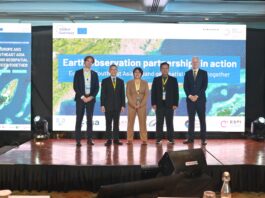To recognize his important scientific undertaking on the development of vehicle drive cycles and testing protocols as well as life cycle assessment (LCA)-based dynamic energy and emissions models for evaluating alternative motor vehicle propulsion, Dr. Jose Bienvenido Manuel M. Biona was chosen as one of the grantees of the annual Outstanding Young Scientist (OYSI) award spearheaded by the National Academy of Science and Technology, Philippines (NAST Phl). The said award is in recognition to outstanding young individuals not more than 40 years old (in the year of the award) who has made exemplary contributions to science and technology. The stated models and methodologies have been significant in developing transport technology and policy evaluation for the Philippines.
As Director of the Center for Research and Training at Don Bosco Technical College prior to joining De La Salle University (DLSU), he initiated a number of clean vehicles research projects which involved technical, economic, and environmental evaluation of various alternative tricycle technologies and analysis of the long term life cycle soundness of various phase-out policies and standards. The evaluation made use of the drive cycle based vehicle performance, energy, and environment simulation tools which provides an alternative way of quantifying emission and fuel economy factors through steady state dynamometer testing and computer simulation.
He also led a team in the evaluation of the different ways in utilizing waste cooking oil in jeepneys including running on pure oil with pre-heating, mixing the crude with diesel and mixing used oil biodiesel with diesel. Further, he headed a DOST-ETV panel in the evaluation of the LPG fumigation technology for jeepney engines and initiated a program on the technical and life-cycle assessment of energy utilization pathways for jatropha press cakes.
He has been involved in electric vehicle-related initiatives which include the development of simulation models for hybrid-electric and plug-in electric tricycle for the local market, which was also used to analyze the long term economic and technical viability of the technology in jeepneys and tricycles. Results of the study have been shared in various for and utilized in the green transport planning in various identified cities.
Dr. Biona is involved in many diversified projects and consultancies from different institutions here and abroad. He has also convened to many local and international conferences. He is member of the Electric Vehicles Alliance and Partnership for Clean Air and sits as a Board Member of the Electric Vehicles Association of the Philippines (EVAP). Moreover, he is member of the technical working group tasked to formulate the standards for electric vehicles in the country and also serves as a consultant for the Energy and Environment program of the Congressional Commission for Science, Technology and Engineering (COMSTE). His work has produced a number of internationally refereed papers in high impact research publications such as the Transportation Research and Clean Technology and Environmental Policy journals.
He finished his Bachelor of Science degree in Mechanical Engineering from Don Bosco Technical College in 1995. He received his masters and doctorate degrees in Mechanical Engineering from De La Salle University (DLSU) with support from the Philippine Council for Industry, Energy, and Emerging Technology Research and Development (PCIEERD) Scholarship of the Department of Science and Technology (DOST) and DLSU Graduate Student Fellowship programs.
Dr. Biona is currently an Associate Professor in the Mechanical Engineering Department and a Research Scientist at the Center for Engineering and Sustainable Development Research of the De La Salle University. In addition, he is also leading the German Agency for International Development (GIZ) funded mobile emissions inventory and port emissions inventory modeling projects in Iloilo City and Cagayan De Oro, in cooperation with the local universities in the area. The mobile emissions model being developed is designed to provide the hourly vehicular emissions for each street in the city throughout the year. Results will be combined with area and stationary emissions and fed to a dispersion modeling tool to simulate ambient air quality for baseline conditions and under various traffic policy, rerouting and vehicle technology scenarios, emission load addition or reductions, and re-zoning plans. Luningning Samarita, Executive Director, NAST




